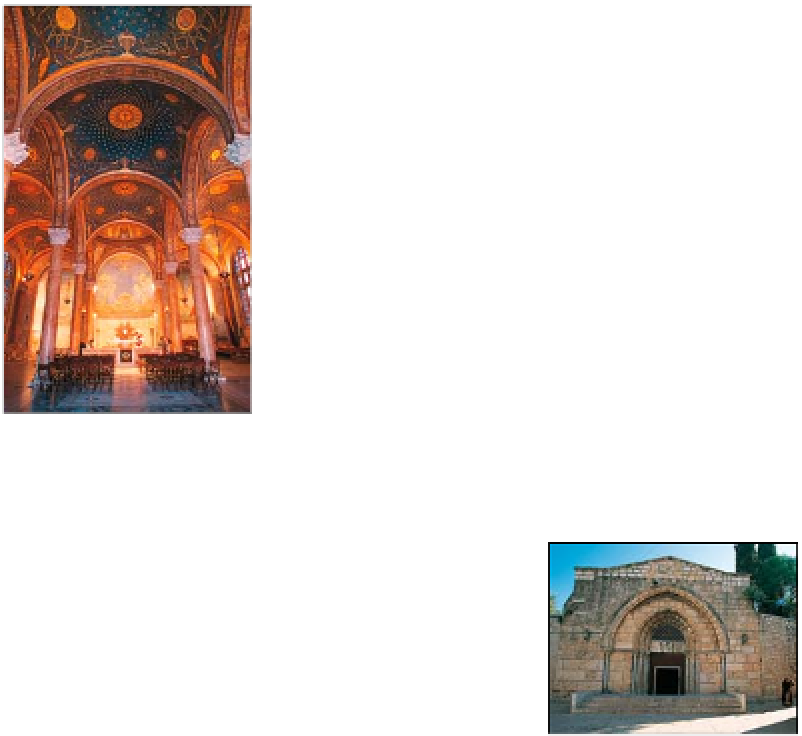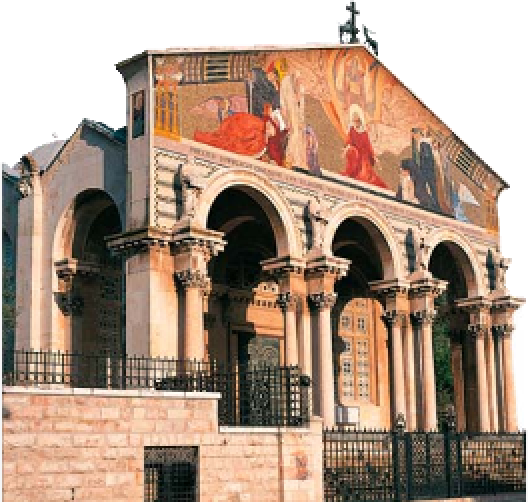Travel Reference
In-Depth Information
After excavation of the site in
the early 20th century, the
present church was designed
by Antonio Barluzzi
(see p113)
and built in 1924 with financial
contributions from 12 nations -
hence the church's name and
its 12 domes decorated with
national coats of arms. In the
centre of the nave is the rock
of the Byzantine church,
surrounded by a wrought-iron
crown of thorns. The mosaic
in the apse represents Christ's
agony, while others depicting
his arrest and Judas's kiss are
at the sides. The plan of the
Byzantine church is traced in
black marble on the floor, and
sections of Byzantine mosaic
pavement can also be seen.
Outside, the gilded mosaic
scene decorating the pedi-
ment also depicts the Agony.
Next to the church is the
surviving part of the Garden
of Gethsemane with its
centuries-old olive trees.
places in Jerusalem. The façade,
the impressive flight of 47 steps
and the royal Christian tombs
in side niches half-way down
all date from the 12th century.
The tomb on the right, going
down, was originally the
burial place of Queen Meli-
sande of Jerusalem, who died
in 1161. Her remains were
moved into the crypt in the
14th century and the tomb has
been venerated since about
that time as that of St Anne
and St Joachim, Mary's parents.
The first tomb was cut in the
hillside here in the 1st century
AD. The cruciform crypt as
seen today, much of it cut into
solid rock, is Byzantine. By the
5th century, an upper chapel
had also been built. This was
destroyed by the Persians in
614, rebuilt by the Crusaders,
Mosaic-decorated, vaulted ceiling in
the Church of All Nations
Church of All
Nations
7
Jericho Rd.
Map
2 E3
.
Tel
(02) 626
l
6444.
@
99.
#
8am-noon &
2:30-5pm (summer: 6pm) daily.
Tomb of the
Virgin
8
Jericho Rd.
Map
2 E3
.
Tel
(02) 628
The Church of All Nations is
also known as the Church of
the Agony because it is built
over the rock in the Garden
of Gethsemane on which it is
believed Christ prayed the
night before he was arrested.
The 4th-century church built
here was destroyed in an earth-
quake in 747. The Crusaders
built a new one, aligned differ-
ently to cover three outcrops
of rock, recalling Christ's three
prayers during the night. It was
consecrated in 1170,
but fell into
disuse after
1345.
l
4054.
@
99.
#
8am-noon &
2:30-5pm daily.
Cave of
Gethsemane
#
8:30am-noon &
2:30-5pm (winter: 3:30pm) daily.
The 12th-century entrance to the
atmospheric Tomb of the Virgin
but again destroyed by Saladin
in 1187. He left the crypt, how-
ever, largely intact.
The Tomb of Mary stands in
the eastern branch of the crypt,
which is decorated with icons
and sacred ornaments typical
of Orthodox Christian tradition.
Today, religious services are
held here by Greek, Armenian,
Coptic and Syrian Christians.
In the southwestern wall
beside the Tomb of Mary is a
mihrab installed after Saladin's
conquest. The place was
sanctified by Muslims because,
according to the 15th-century
scholar Mujir al-Din, Muham-
mad saw a light over the tomb
of his “sister Mary” during his
Night Journey to Jerusalem
(see
p27)
. In the opposite wall, a
1st-century tomb is evidence of
the site's earliest use for burials.
Outside, to the right of the
façade, is the
Cave of Gethse-
mane
, or Cave of the Betrayal,
the traditional place of Judas's
betrayal. It was once used for
oil pressing, but fragments of
4th-5th-century mosaics bear
Believed to be where the
Disciples entombed the Virgin
Mary, this underground
sanctuary in the Valley of
Jehoshaphat is
one of the most
intimate and
mystical
holy
The Church of All Nations in the Garden of Gethsemane
For hotels in this area see p256








